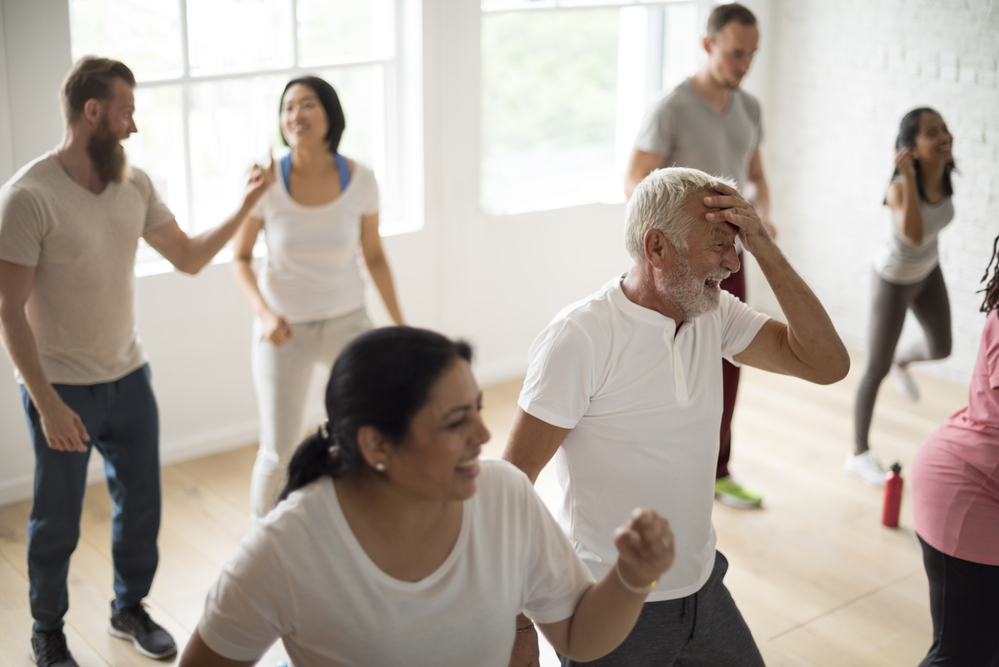A new study published in the British Journal of Sports Medicine finds that physical activity (PA) can improve symptoms of depression, anxiety, and overall psychological distress.
According to the review of research, exercise is effective across a wide range of adult populations. It was most effective for people with depression, HIV, kidney disease, pregnant and postpartum women, and healthy individuals. More intense exercise was linked to more significant symptom improvement. However, the effectiveness of physical activity in treating symptoms of depression, anxiety, and distress diminished over time. The authors write:
“Physical activity is highly beneficial for improving symptoms of depression, anxiety, and distress across a wide range of adult populations, including the general population, people with diagnosed mental health disorders, and people with chronic disease. Physical activity should be a mainstay approach in the management of depression, anxiety, and psychological distress.”
 The present work set out to evaluate the efficacy of physical activity in reducing symptoms of depression, anxiety, and distress. To accomplish this goal, the authors searched 12 electronic databases for meta-analyses of randomized control trials (RCT) that assessed the relationship of physical activity to symptoms of depression, anxiety, and psychological distress. The present study includes 1039 trials with 128,119 participants.
The present work set out to evaluate the efficacy of physical activity in reducing symptoms of depression, anxiety, and distress. To accomplish this goal, the authors searched 12 electronic databases for meta-analyses of randomized control trials (RCT) that assessed the relationship of physical activity to symptoms of depression, anxiety, and psychological distress. The present study includes 1039 trials with 128,119 participants.
To be included in the current work, each meta-analysis had to have a design intended to increase physical activity in adult populations (aged 18 years or older). In addition, studies were excluded if they investigated any RCT of non-PA interventions, if PA was combined with some other kind of intervention (diet, for example), or if the analyses looked at a single instance of PA. Meta-analyses were also excluded if a significant portion (more than 25%) of their component studies included comparisons between PA and pharmaceutical interventions or compared two types of PA without a non-PA control.
To compare studies that used different assessments of depression, anxiety, and psychological distress, the authors used a measure called standardized mean difference (SMD). An SMD of +- 0.2-0.5 indicates a small effect size, +-0.5-0.8 indicates a medium effect size, and > +- .8 indicates a large effect size. PA was effective in reducing depression (SMD = -.43), anxiety (SMD = -.42), and psychological distress (SMD = -.6) across all populations examined.
PA was effective in reducing symptoms of depression across all clinical diagnoses examined by the present work. The largest reduction in symptoms was found in people diagnosed with kidney disease (SMD = -.85), HIV (SMD = -.84), chronic obstructive pulmonary disease (SMD = -.72), and depression (SMD = -.62). The healthy adult population also saw a significant reduction of depression symptoms when engaging in increased PA (SMD = -.62).
PA was also effective in reducing anxiety in most of the clinical populations examined. It was most effective in people diagnosed with HIV (SMD = -1.23), kidney disease (SMD = -.78), and chronic obstructive pulmonary disease (SMD = -.55). PA was also effective in reducing anxiety in healthy adults (SMD = -.85). The authors note that the evidence for PA reducing anxiety was limited except for in the cases of cancer (SMD = -.24) and anxiety disorders (SMD = -.43).
Reduction of depression symptoms was linked to the intensity of PA, with low-intensity exercise (SMD = -.22) showing significantly less promise than moderate (SMD = -.56) and high-intensity (SMD = -.70) workouts. Moderate (SMD = -.47) and high-intensity (SMD = -.44) workouts were more effective in reducing anxiety than low-intensity (SMD = -.26) PA.
The effectiveness of PA for treating both depression and anxiety symptoms was reduced with longer-duration interventions. For symptoms of depression, interventions lasting less than 12 weeks (SMD = -.84) showed significantly more efficacy than those lasting 12-23 weeks (SMD = -.46) and 24 weeks or more (SMD = -.28). Anxiety symptoms saw a similar pattern of reduced effectiveness at longer durations with interventions lasting less than 12 weeks (SMD = -..55) and between 12 – 23 weeks (SMD = -.47) outperforming interventions lasting 24 weeks or longer (SMD = -.15).
The authors acknowledge two limitations to the current work. First, most reviews focused on mild to moderate depression rather than anxiety or psychological distress. As such, the evidence for PA’s relationship to anxiety and psychological distress is less strong.
Second, most of the included reviews were rated “critically low” regarding the AMSTAR-2 quality rating. The included studies also used different measures of anxiety, depression, and psychological distress. While the use of SMD is intended to compare reviews that use different measures, there is an assumption that the differences observed are due to the measurement tools rather than differences that exist between these populations. There is no guarantee that this is true.
The authors conclude:
“PA is effective for managing symptoms of depression and anxiety across numerous populations, including the general population, people with mental illnesses, and various other clinical populations. While the benefit of exercise for depression and anxiety is generally recognized, it is often overlooked in the management of these conditions. Furthermore, many people with depression and anxiety have comorbidities, and PA is beneficial for their mental health and disease management. This underscores the need for PA to be a mainstay approach for managing depression and anxiety.”
Previous research has found that PA can be effective in preventing depression. For example, one study found that PA predicts fewer depressive symptoms in children. Another piece of research found that exercise was associated with a 25% lower risk for depression.
A recent meta-analysis from 2022 found that exercise was just as good as antidepressants at alleviating symptoms of moderate depression and that exercise could be used in place of these addictive drugs. Another meta-analysis found that the effects of exercise on depression are likely underestimated.
****
Singh, B., Olds, T., Curtis, R., Dumuid, D., Virgara, R., Watson, A., Szeto, K., O’Connor, E., Ferguson, T., Eglitis, E., Miatke, A., Simpson, C. E. M., & Maher, C. (2023). Effectiveness of physical activity interventions for improving depression, anxiety, and distress: An overview of systematic reviews. British Journal of Sports Medicine. https://doi.org/10.1136/bjsports-2022-106195 (Link)















“While the benefit of exercise for depression and anxiety is generally recognized, it is often overlooked in the management of these conditions.”
Actually, “the benefit of exercise for depression and anxiety is generally” unrecognized – by the DSM “bible” billers – based upon their DSM definition of the “symptoms of depression.” Which, according to the DSM state, a sign of “depression” is, “Significant weight loss when not dieting or weight gain, or decrease or increase in appetite nearly every day.”
A definition of “depression,” which totally ignores the concept that one may lose weight via exercise, or PA.
“Physical activity should be a mainstay approach in the management of depression, anxiety, and psychological distress.”
I agree. And I know this common sense must be repeatedly communicated to the DSM deluded “mental health professionals” who think losing weight, due to exercise, as opposed to dieting, makes one “depressed.” Which is the opposite of the truth, thus their belief system is insane.
And my “mental health professionals” proved their stupidity and insanity, in regards to their denial of the benefits of exercise, when I was encouraged to stop exercising by them. Which is part of why I had to stop seeing them.
Let’s hope and pray the DSM deluded some day wake up to the truth that regular moderate exercise is a good and healthy way to lose weight, and can help one gain higher self esteem, as opposed to making one “depressed.”
I’ve never met more insane people than DSM “bible” billers, who think losing weight via exercise, and upon the recommendation of a doctor, is a symptom of “depression.”
Report comment
As I age, I find that there is something positive about losing some of my youthful body. It has caused me to see my body in a new light. In my opinion, this is one of the main reasons why psychiatry does not prioritize behavior and physical well-being. While this is just my personal view and it may not be unique, I believe that if psychiatrists were to encourage people to take control of their muscles and movements, it could lead to a greater awareness of how individuals can influence the contents of their minds. It could help people realize that thoughts and feelings are just contents without merit unless one acts on them or moves their muscles in response.
Ironically, psychiatry may be against individual autonomy, despite the fact that individuality and autonomy are highly valued in society. Perhaps, without sounding too cynical, this is the engineering of the society: to control people’s minds and prevent them from being aware of their muscles and movements. People may be made to fear their thoughts and feelings so much that they lack the energy to even consider moving their bodies.
Can you imagine how much body movement supported by psychiatry could go rather than focusing on judging the inner and unique thoughts of the individual and reifying them to replace the true movement of the body?
Report comment
Not to mention the degree to which psychiatric “treatment” leads to an INABILITY to move one’s body in a normal fashion, tardive dyskinesia, EPS, akathisia, etc.
Report comment